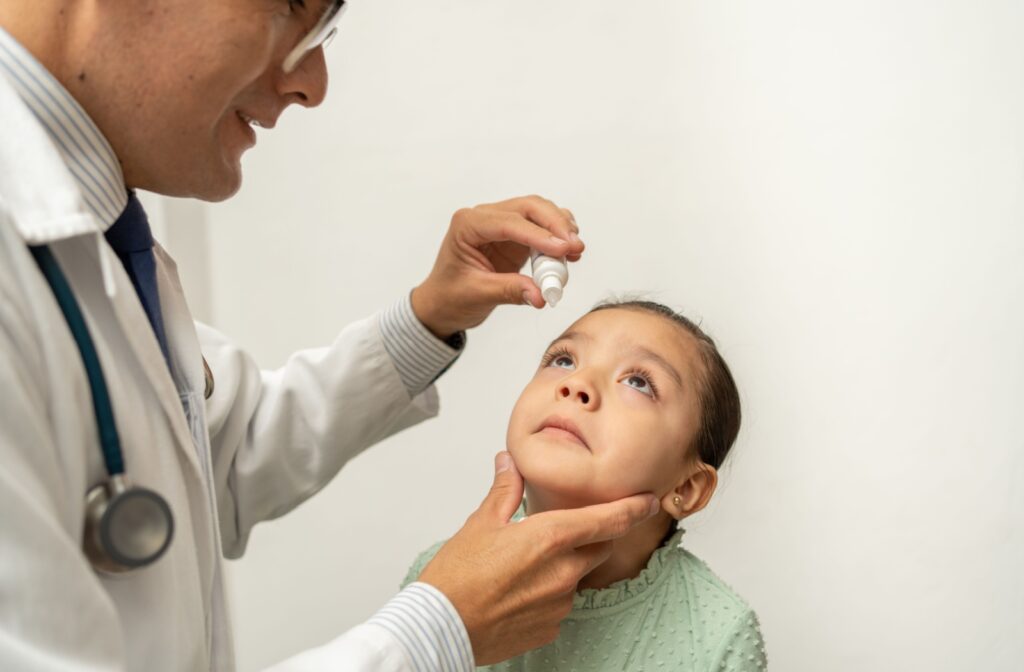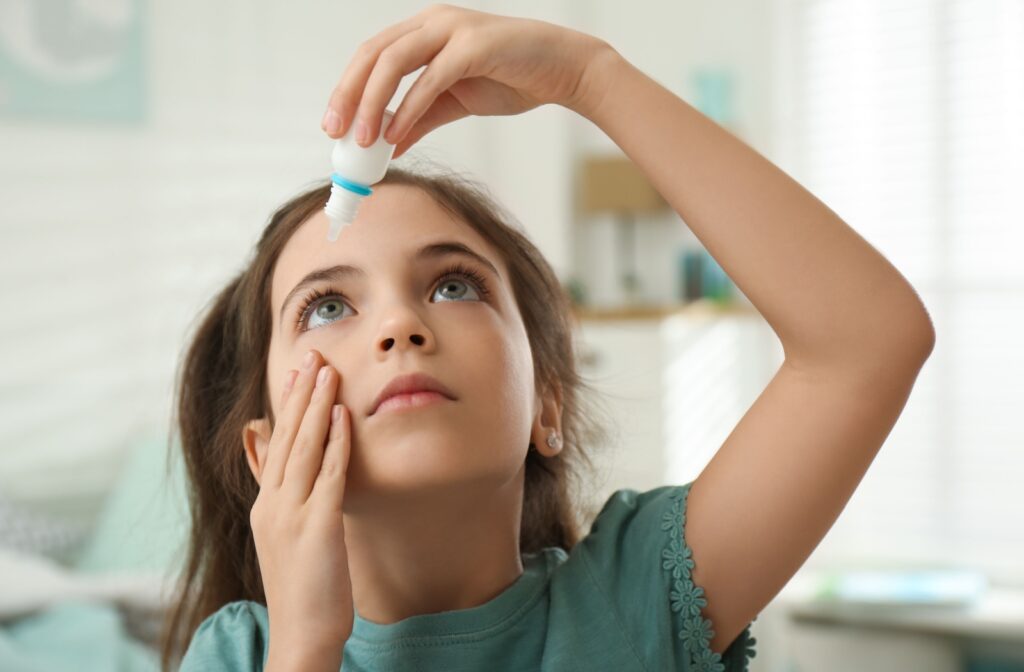Eye issues in children can be concerning, whether it’s redness, itchiness, or dryness resulting from prolonged screen time. Eye drops often come to mind as a quick solution for minor issues—fortunately, there are eye drop options that are safe for kids to use.
Not all eye drops are equal or work the same, though. It’s essential that your child uses eye drops that are safe for children and that you follow both your eye doctor’s and the manufacturer’s usage instructions.
What Are Eye Drops & How Do They Work?
Eye drops are liquid medications designed to treat a specific eye condition or provide relief from symptoms such as dryness or irritation. Depending on their purpose, eye drops may contain active ingredients such as antihistamines, antibiotics, or lubricants, all of which are delivered directly into the eye for fast, targeted relief.
When applied correctly, eye drops can help soothe discomfort, reduce inflammation, and even prevent or treat infections. This versatility makes them an effective tool for both adults and children when used appropriately.
Can My Child Use Eye Drops?
Yes, most kids can use eye drops, but it depends on the type of eye drops and the reason they’re needed. Some eye drops, such as saline or artificial tears, are generally safe for children and even infants. But medicated eye drops for infections, allergies, or other conditions should always be prescribed by a pediatrician or eye doctor.
It’s also worth mentioning that certain over-the-counter (OTC) drops may contain ingredients that aren’t ideal for kids, so it’s crucial to consult your child’s doctor before using them. The key is to ensure that the product matches your child’s specific eye health needs.
Common Eye Conditions in Kids That Require Eye Drops
Several common eye conditions in children may require the use of eye drops. These include:
- Dry eyes: Caused by extended device use or environmental factors. Artificial tears can provide relief
- Pink eye (conjunctivitis): Antibiotic drops may be prescribed for bacterial conjunctivitis, while lubricating drops may soothe viral or allergic conjunctivitis
- Eye allergies: Antihistamine eye drops can reduce itching, redness, and swelling triggered by allergens like pollen
- Foreign object irritation: Saline solution or artificial tears can flush out particles like dust or sand
- Styes: Some eye drops can help reduce inflammation and speed up healing
Always double-check with your child’s eye doctor before treating any of these conditions on your own.

Correct Dosage & Administration
Using eye drops can be tricky with kids, especially if they’re squirmy or anxious. Here are some general guidelines for safe administration:
- Check the instructions: Dose and frequency vary depending on the type of eye drops. Follow the label or your doctor’s advice.
- Wash your hands: Clean hands reduce the risk of introducing bacteria into your child’s eye.
- Position your child: Have your child lie back or tilt their head slightly. This makes applying drops easier.
- Use the lower lid technique: Gently pull down their lower eyelid to create a small pocket for the drops.
- One drop at a time: Apply one drop into the pocket. Don’t worry if your child blinks; it’s common and won’t compromise effectiveness.
Possible Side Effects & Precautions
Like any medication, eye drops can occasionally cause side effects, which highlights the importance of following usage directions. Some potential side effects include:
- Temporary stinging or burning
- Redness or increased tearing
- Irritation or allergic reaction to the ingredients
If your child experiences severe reactions like swelling, rash, or persistent discomfort, stop using the product immediately and contact a doctor.
Additionally, never share eye drop bottles with family members (as doing so can spread infections), and always store them in a cool, dry place away from direct sunlight and heat.
Tips for Administering Eye Drops to Kids
Administering eye drops doesn’t have to feel like a chore. These tips can make the process easier for both you and your child:
- Make it fun: Turn it into a game or use a reward system. For example, praise them or offer a small sticker as a reward.
- Explain it step by step: Assure your child that the eye drops will help them feel better. Keep your tone calm and reassuring.
- Be quick and confident: Kids can sense hesitation, so staying composed can help them feel at ease.
- Use distractions: Play their favorite song, read them a story, or ask them to count ceiling tiles while you administer the eye drops.
Are There Alternatives to Eye Drops for Kids?
Not every eye issue requires drops.
Non-Medicated Solutions
- Cold compress: Placing a clean, cool cloth over your child’s eyes can help soothe irritation and reduce puffiness
- Saline rinse: For minor irritations, gently flushing your child’s eye with saline solution can be effective
Eye-Friendly Habits
Encourage your child to adopt habits that promote overall eye health, such as:
- Taking regular breaks from screens (use the 20-20-20 rule)
- Wearing sunglasses outdoors to protect from UV rays.
- Eating a diet rich in eye-friendly nutrients like omega-3 fatty acids, lutein, and vitamin A
These small changes can make a big difference in preventing common eye discomforts.
Discuss Eye Drop Options with Your Child’s Eye Doctor
No two kids are the same, which is why it’s essential to consult your child’s eye care provider before using eye drops or other treatments. An eye doctor can provide personalized recommendations, ensuring your little one’s eyes are getting precisely what they need to stay healthy. Ultimately, your child’s comfort and safety are paramount. Take time to educate yourself about eye health, follow expert advice, and don’t hesitate to reach out with questions. Contact our expert team at Visionary Eye Care today if you have questions about safe eye drop use for your child.



